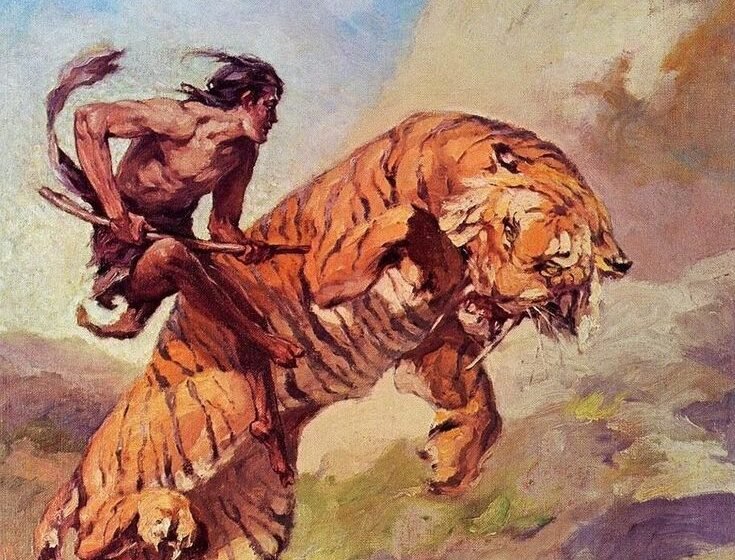A Foolish Tiger : Outwitting the Predator

-Trushti Dand
Can intelligence outmatch brute strength? The folktale A Foolish Tiger explores this age-old question through the story. This fable, rooted in traditional wisdom, highlights the power of wit over sheer physical force, teaching us that intellect and presence of mind can be the greatest weapons in difficult situations.
A Foolish Tiger revolves around three central characters: a wise jackal, a helpless tortoise, and a powerful but gullible tiger. The tale begins with a jackal and a tortoise, who are close friends living near a pond in the forest. The jackal resides in a cave close to the water, while the tortoise makes its home in the pond. One day, as the two friends are chatting, a hungry tiger appears. The jackal, being quick on its feet, immediately runs to its cave and hides. However, the slow-moving tortoise has no such escape route. Seizing the opportunity, the tiger captures the tortoise and attempts to eat it.
However, the tiger faces an unexpected challenge—the tortoise is protected by its hard shell. The tiger tries everything in its power to break through, using its paws, claws, and sharp teeth, but all its efforts are in vain. Frustrated and exhausted, the tiger continues to struggle, unaware that it is being watched by the jackal.
Recognizing the danger his friend is in, the jackal devises a clever plan. Coming out of hiding, he pretends to be on the tiger’s side and offers advice. He tells the tiger that the tortoise’s shell is too hard now, but if it is soaked in water for some time, it will become soft—soft enough to be eaten easily. The tiger, being foolish and gullible, believes the jackal’s words without questioning them.
Following the jackal’s suggestion, the tiger gently pushes the tortoise into the pond, thinking it will soon be able to feast on it. But as soon as the tortoise hits the water, it swiftly swims away, diving deep to ensure its safety. The tiger watches helplessly from the bank, realizing too late that it has been tricked.
The jackal’s cleverness saves his friend’s life, while the tiger’s foolishness costs him his meal. Through its engaging narrative, A Foolish Tiger teaches an enduring lesson: quick thinking and intelligence can be far more powerful than physical strength.
Folktales like A Foolish Tiger have played a crucial role in passing down wisdom through generations. Rooted in ancient oral traditions, such stories were used to teach valuable life lessons, especially in societies where formal education was limited. This tale, like many fables, emphasizes intelligence and quick thinking over brute strength.
The tiger represents raw power and dominance, while the jackal symbolizes cunning and adaptability. The tortoise, with its resilience, highlights the value of patience and survival through strategy. Stories featuring jackals and tigers are common in Indian and Southeast Asian folklore, such as the Panchatantra and Jataka Tales, where weaker creatures outwit stronger foes, reinforcing the idea that wisdom triumphs over might.
Additionally, the story promotes the importance of friendship and loyalty, as seen in the jackal’s clever intervention to save the tortoise. It also warns against gullibility, as the tiger’s failure to question the jackal’s advice leads to its loss. The folktale continues to be relevant today, reminding people of the power of intelligence, resourcefulness, and critical thinking in overcoming challenges. Through this simple yet profound tale, cultural values of wisdom, caution, and community support are reinforced across generations.
The folktale A Foolish Tiger carries several important themes that provide moral lessons applicable to everyday life.
One of the central themes is intelligence over brute strength. The tiger, though powerful, lacks wisdom, while the jackal, a much smaller animal, uses its cleverness to outsmart the tiger and save its friend. This reflects the idea that intelligence and strategy are more valuable than physical strength alone, a common lesson found in traditional Indian fables like the Panchatantra.
Another important theme is friendship and loyalty. The jackal proves to be a true friend by taking a risk to help the tortoise. This highlights the importance of standing by loved ones in times of danger and using one’s skills for the benefit of others.
The theme of deception and gullibility is also evident. The jackal tricks the tiger with a false idea that water will soften the tortoise’s shell. The tiger, lacking critical thinking, blindly trusts the jackal and loses its prey. This teaches the importance of questioning advice and not believing everything without careful thought.
Lastly, survival and adaptability play a key role in the story. The tortoise survives because of its natural defense mechanism, while the jackal adapts to the situation by using quick wit. This reinforces the idea that survival often depends on intelligence, not just physical strength.
Overall, the folktale conveys timeless lessons on wisdom, friendship, and the dangers of foolishness, making it a valuable moral story for both children and adults.
A Foolish Tiger employs various symbols and literary devices to enhance its moral lessons and storytelling. The tiger represents brute strength and gullibility. Despite being a powerful predator, he is easily deceived, symbolizing how intelligence can triumph over physical power. In contrast, the jackal symbolizes wisdom and cunning. He uses his intelligence rather than force to solve problems, demonstrating the value of clever thinking. The tortoise represents patience and resilience, with its hard shell serving as both a literal and metaphorical shield, emphasizing the importance of natural defense mechanisms in the face of danger. The pond acts as a symbol of escape and safety, providing the tortoise a means of survival and highlighting how the right environment can offer protection.
The story also employs several literary devices. Irony plays a major role, as the fearsome tiger is outwitted by a small jackal, creating situational irony. Foreshadowing is evident in the jackal’s quick thinking, which hints at his ability to manipulate the tiger. Personification brings the animals to life by giving them human-like intelligence and emotions, making the story engaging and relatable. Additionally, dialogue is crucial, as the jackal’s speech is what ultimately tricks the tiger, showcasing how words can be more powerful than brute strength. These symbols and literary devices make the folktale memorable, reinforcing its moral lessons in an entertaining and thought-provoking way.
A Foolish Tiger remains relevant in modern times as it highlights the importance of intelligence, strategic thinking, and problem-solving over brute force. In today’s world, where competition exists in every field—whether in academics, business, or personal life—success often depends more on wit and quick thinking than mere strength or resources. The jackal’s cleverness represents the power of adaptability and creativity, qualities essential for thriving in the modern era. The story also serves as a reminder that blindly trusting others without critical thinking, like the tiger did, can lead to unfavorable consequences. This applies to social media, politics, and business, where misinformation can easily manipulate people into making poor decisions.
The tortoise’s resilience symbolizes the ability to withstand difficulties and use one’s strengths wisely. In today’s fast-paced life, patience and endurance are key to overcoming challenges. The pond, representing a safe haven, reflects how people should seek supportive environments that help them grow and escape harmful situations. The story also underscores the need for teamwork, as the jackal and tortoise work together to outsmart the tiger, reinforcing the value of friendship and mutual support in achieving success. Ultimately, A Foolish Tiger teaches timeless lessons about intelligence, caution, and the power of resourcefulness, making it relevant across generations.
The folktale delivers a timeless lesson on intelligence, resourcefulness, and the consequences of blind trust. Through the clever jackal, the resilient tortoise, and the gullible tiger, the story emphasizes that wit often triumphs over brute strength. It highlights the importance of critical thinking, quick decision-making, and cooperation, which remain relevant in today’s world. The tale also warns against naivety and the dangers of believing everything at face value, a lesson particularly important in the modern digital age.
Beyond its moral teachings, the folktale reflects cultural values of wisdom, friendship, and strategic survival, which are deeply embedded in folklore traditions. It serves as a reminder that intelligence, adaptability, and teamwork can help overcome even the most difficult challenges. Whether in ancient times or today, A Foolish Tiger continues to inspire readers with its simple yet profound message: knowledge and cleverness will always outshine brute force.


